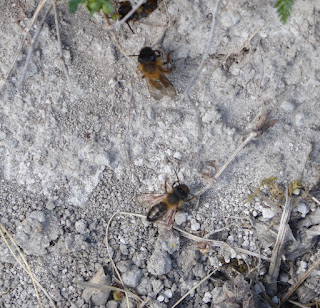The sun has been out and the sightings have continued to pile up.
Last Tuesday (19th) I went to the Spetchells, partly hoping that the buffish mining bees wouldn't be out in force enabling me to search for other species such as ashy or tawny mining bees. In fact they were out in their usual tens of thousands making it hard to concentrate on much else and Gooden's Nomad Bee was again the only non-bumblebee seen. Both were up to their usual tricks.
|
|
In fact the main other species of note were a nice small tortoiseshell and the first speckled wood I have seen, which meandered out of some woodland when I was on my way back to the bike.
|
|
 |
| Comma |
But sightings and my knowledge frontier really took off on Saturday when I went on a bee and hoverfly walk with the Natural History Society of Northumbria at Morpeth.
I knew there was a possibility of seeing a tawny mining bee but it was a bit of a surprise to find one running the line at Morpeth Rugby Club before we had even set off on the walk!
 |
| Tawny Mining Bee |
Although my expertise was considerably outshone by others in the group, I can take credit for seeing the first bee after we set out - a species I'd never heard of before Saturday, the hawthorn mining bee. I was also the first to identify a cuckoo bee crawling around some undergrowth that turned out to be a vestal cuckoo bumblebee. In the meantime, a rather nice looking wee blood bee had turned up. Apparently it's tricky to be sure about precisely which kind of blood bee it was as there are many varieties.
 |
| Blood Bee |
However our most spectacular sighting was a fly, Ferdinandea cuprea, identified confidently by our leader Mark as only having been recorded in Northumberland on five previous occasions. I don't do flies other than bee imitators but collected the evidence nevertheless:
 |
| Ferdinandea cuprea |
By contrast this cream spot ladybird is apparently our most common UK lady bird species. I must say I had no idea of this. Perhaps I should get more interested in spotting ladybirds though it does seem to involve a lot of crawling around in the undergrowth.
 |
| Cream Spot Ladybird |
Perhaps it was the next sighting that got me thinking the most. I'm sure I read somewhere that there are only two nomad bees occurring in the North East - Gooden's and Marsham's - but this one was identified as a Lathbury's Nomad Bee:
 |
| Lathbury's Nomad Bee |
A bit hard to see but there is a definite red stripe at the top of the abdomen.
Louise who spotted it says there are definitely five species of nomad bee in the North East and this has got me thinking that the one I've been seeing in the garden may not be a Gooden's as I have tended to assume. I must get a closer look at it when the sun comes out again.
Another nice sighting was an early bumblebee queen, the first I've seen this year:
Early Bumblebee Queen
Sandpit Mining Bees
There's a clear lesson to be taken from this - it's amazing what you can see on a half mile walk, especially when you're with people who know what they're talking about!




No comments:
Post a Comment